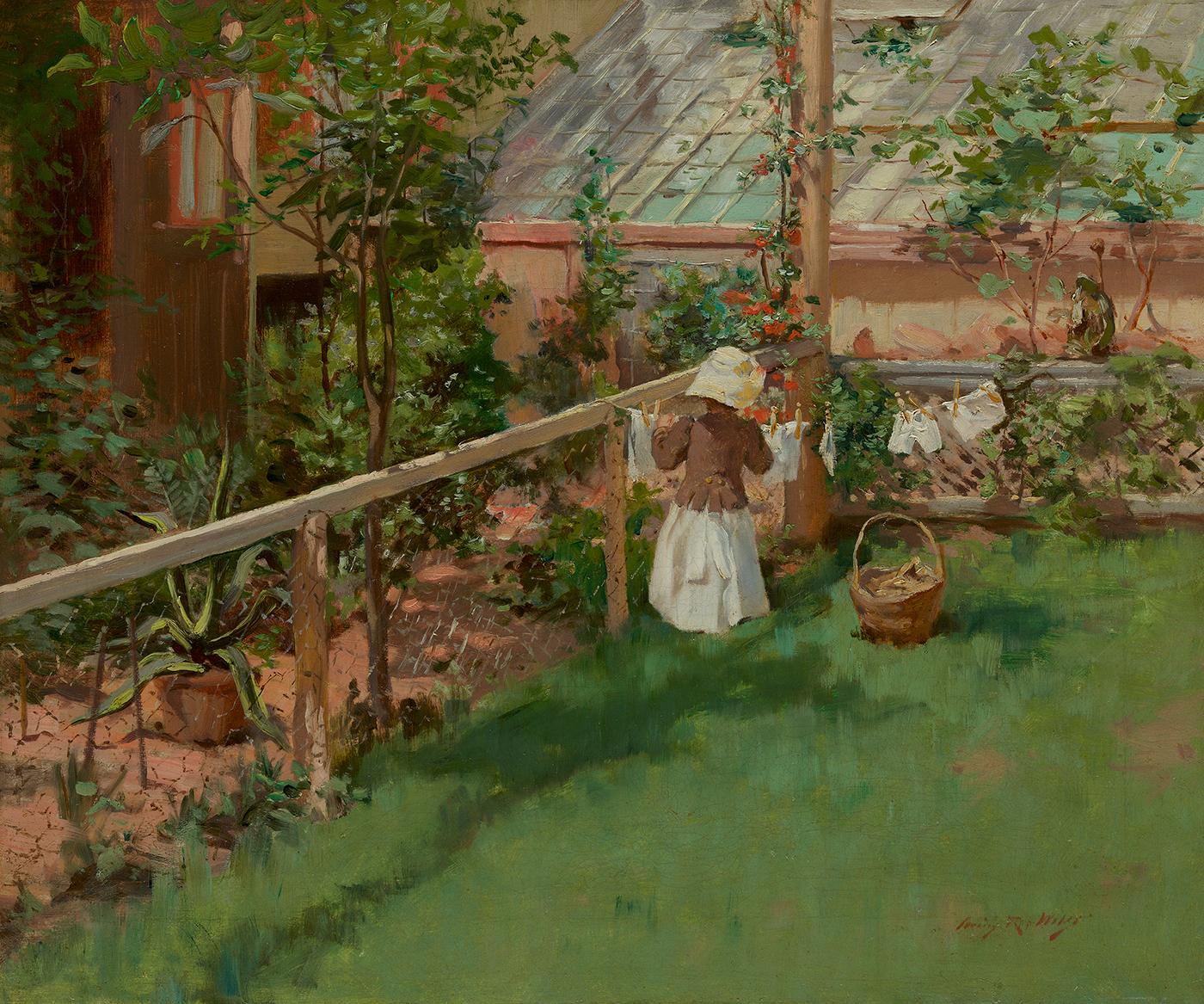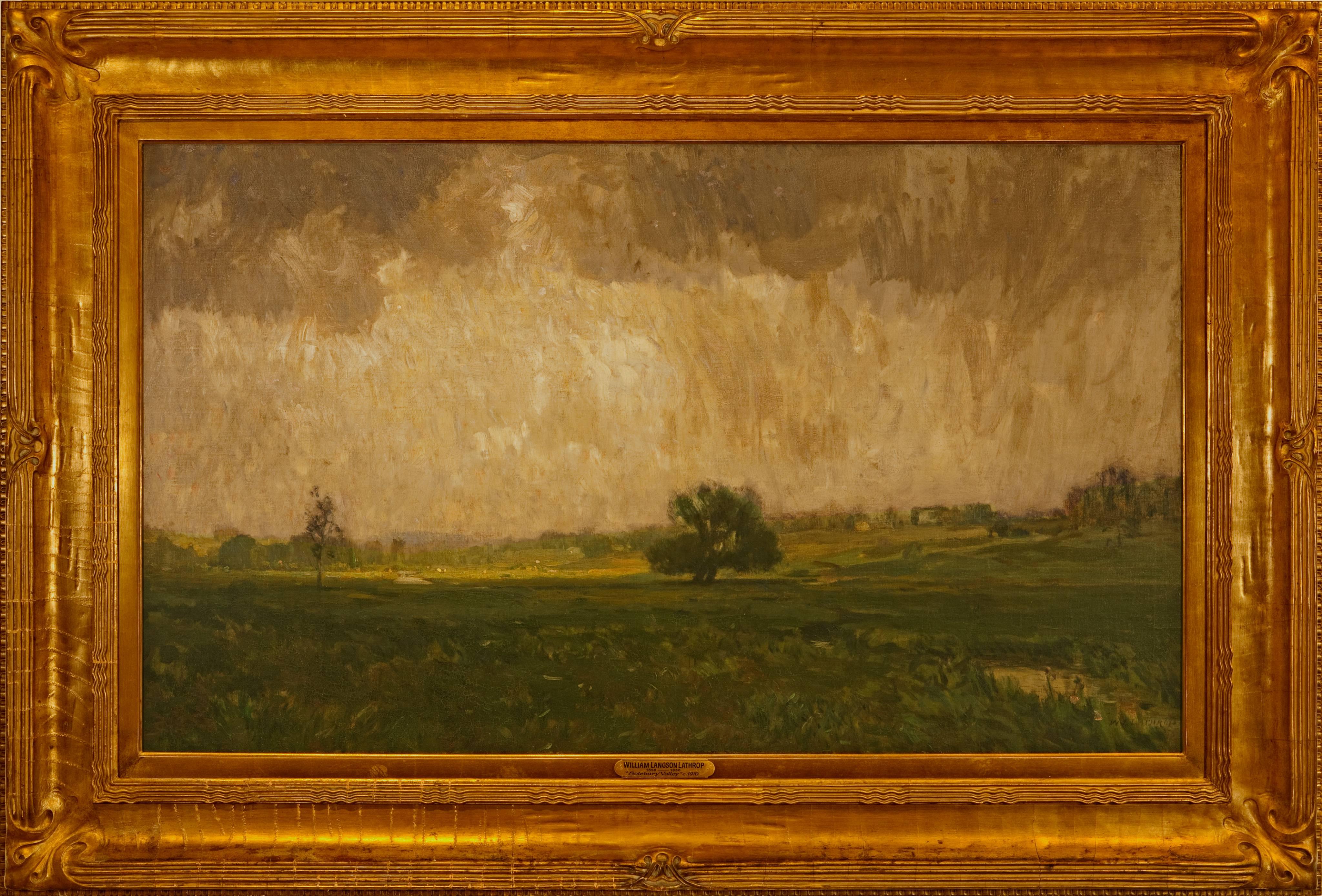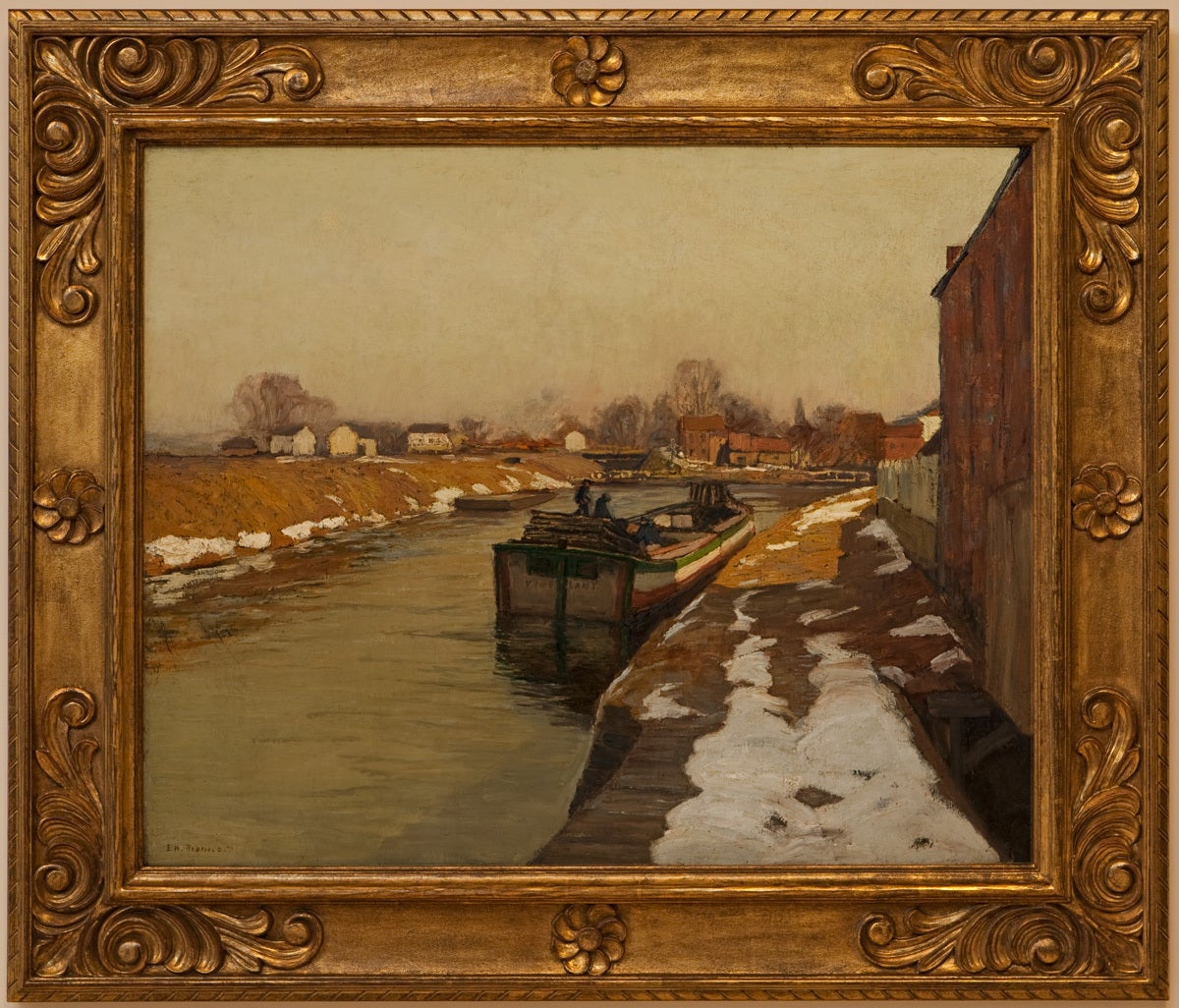Items Similar to "Mountain Village in Winter" Anthony Thieme, Snowy Landscape
Want more images or videos?
Request additional images or videos from the seller
Anthony Thieme"Mountain Village in Winter" Anthony Thieme, Snowy Landscape
About the Item
Anthony Thieme
Mountain Village in Winter
Signed lower left
Oil on canvas
25 x 30 inches
Anthony Thieme was born in the Dutch port city of Rotterdam in 1888. He studied at the Academy of Fine Arts in Rotterdam, at the Royal Academy at the Hague, as an apprentice to George Hoecker, a well known stage designer in Düsseldorf, Germany, and to Antonio Mancini, an Italian Impressionist. After completing his studies, Thieme journeyed throughout Europe and South America, working in stage design to support his travels. Thieme first came to the United States in 1917 and initially worked as a set designer and book illustrator first in New York and later in Boston.
By the late 1920s, Thieme had married and moved from Boston to Cape Ann in Rockport, Massachusetts, an emerging art colony. Like the other Rockport artists, his style was influenced by Impressionism, with special attention paid to the effects of light, but also by the Dutch tradition of seascape painting. Throughout his career, Thieme favored painting en plein air, or outside, because it allowed him to better capture the atmosphere's fleeting effects. He has been referred to as the "Master of Light and Shadow."
Thieme's paintings were often met with critical acclaim and were displayed at galleries in New York, London, and Paris. He also established the Thieme School of Art at Cape Ann in 1929 and taught classes out of his studio until 1943. Tragedy struck in 1946 when his studio burned to the ground, destroying much of the work he had produced over thirty years. Devastated by this loss, Thieme left Massachusetts in search of new adventures and inspirations. He traveled south to Charleston, South Carolina and was greatly inspired by the dense, tropical foliage and the warm, coastal light. He spent two months in Charleston, painting prolifically, before continuing on to Florida, the Caribbean, and Central America. Until his mysterious death in 1954, Thieme spent his summers in Rockport and the winter months based in St. Augustine, Florida.
Throughout his career, Thieme exhibited his work widely and was active in numerous art associations and clubs. He participated in exhibitions across the country including ones at the Pennsylvania Academy of the Fine Arts, and the Corcoran Gallery in Washington, D.C. He was a member of the National Arts Club, the American Watercolor Society, the Salmagundi Club, the Boston Art Club, the Art Alliance of America, and the Rockport Art Association.
- Creator:Anthony Thieme (1888 - 1954, American)
- Dimensions:Height: 32.5 in (82.55 cm)Width: 38 in (96.52 cm)
- Medium:
- Movement & Style:
- Period:
- Condition:
- Gallery Location:New York, NY
- Reference Number:1stDibs: LU1841213537902
Anthony Thieme
Anthony Thieme was born in Rotterdam, Netherlands, on February 20, 1888. After traveling in Europe, England and South America, Thieme settled in Boston. He established a studio in Rockport on Cape Ann. Thieme became very well known for his seascapes and shore scenes. He established the Thieme School of Art in Rockport, of which he was the director. Thieme died on December 6, 1954, in Greenwich, Connecticut.
About the Seller
5.0
Platinum Seller
These expertly vetted sellers are 1stDibs' most experienced sellers and are rated highest by our customers.
Established in 2021
1stDibs seller since 2022
62 sales on 1stDibs
Typical response time: 1 hour
- ShippingRetrieving quote...Ships From: New York, NY
- Return PolicyA return for this item may be initiated within 3 days of delivery.
More From This SellerView All
- "Trinity Church, Boston" Arthur Clifton Goodwin, Impressionism, Snowy WinterBy Arthur Clifton GoodwinLocated in New York, NYArthur Clifton Goodwin Trinity Church, Boston, 1928 Signed lower left Oil on canvas 30 x 36 inches Provenance: Sotheby’s New York, American Art, May 24, 1990, Lot 166 Private Collec...Category
1920s American Impressionist Landscape Paintings
MaterialsCanvas, Oil
- "Washington Square Park" Marion Eldridge, Female Artist, New York CityscapeLocated in New York, NYMarion Eldridge Washington Square Park, circa 1925-30 Signed lower right Oil on canvas 18 x 22 inchesCategory
1920s American Impressionist Landscape Paintings
MaterialsCanvas, Oil
- "Soir de Novembre, Dordrecht, " Eugene Vail, Dutch Landscape with Boats, CloudyBy Eugène Lawrence VailLocated in New York, NYEugène Laurent Vail (1857 - 1934) Soir de Novembre, Dordrecht Oil on canvas 19 1/4 x 25 3/4 inches Signed lower left; titled in two places on the stretcher with various other inscriptions, stamped "MADAME G:VAIL A" and inscribed "177" in ink and "#43" in pencil on a partial label from Garde-Meuble Maple affixed to the stretcher Eugene Vail (Saint-Servan, France September 29, 1857 - Paris, December 28, 1934), the son of a French mother and an American father, Lawrence Eugene Vail, studied at the Stevens Institute of Technology in Hoboken, New Jersey (where Alfred Stieglitz was born in 1864) and graduated with a degree in mechanical engineering in 1877. Then he became a student of William Merritt Chase and J. Carroll Beckwith at the Art Students League before returning to France. He entered the Ecole des Beaux-Arts in 1882 where he was instructed by Alexandre Cabanel, Raphaël Collin, and Dagnan-Bouveret (1852-1929), known as an extreme naturalist. When Bastien-Lepage died in 1884, Dagnan-Bouveret became the leader of the Naturalist School. He definitely made an indelible impression on Vail. According to Louise Cann, Vail soon became an independent painter working at Pont-Aven and Concarneau. It is difficult to determine when he separated from his teachers since he is listed as a student whenever he exhibited at the Paris Salon — that is, until 1899 when he dropped the mention of élève. A picture of a peasant girl, Seulette was his Salon debut painting in 1883, the same year that he sent two scenes of Brittany to the Pennsylvania Academy of the Fine Arts' exhibition, which documents his stay in that region. The next year he exhibited in the Salon: Fishing Port, Concarneau, which went to the Luxembourg Museum (it is now in the Musée Municipal of Brest). It has the Naturalist brown and gray palette and tonalist atmosphere but already shows that Vail had direct experience with scenes of life in coastal villages: "So convincing was his familiarity with the French coast that the critic Thiébault-Sisson claimed him as a Frenchman and declared that no American marine painter could touch his skill." (Maureen C. O'Brien, in Blaugrund, 1989, p. 218). In 1885, Vail exhibited Inner Port at Dieppe and in the following year On the Thames (Private collection), which later won him the Grand Diploma of Honor from an international jury in Berlin in 1891. Widow, the title of Vail's entry in the Salon of 1887 (unlocated), is a striking image of a woman standing on a beach, looking out to the expanse of the ocean where her husband obviously met his end. The innocent child who looks at us may have the same fate in store for him. Then in 1888, Vail completed his masterpiece, Ready, About! a "wall-size" 94 x 125½ inch canvas. The painting won a first-class gold medal in the Salon of 1888, then at the Paris Universal Exposition of 1889, Vail won another gold medal. The first precedent that comes to mind is Théodore Géricault's colossal Raft of the Medusa of 1819 (Louvre), the celebrated romantic image of castaways about to be rescued after being lost at sea. But while Géricault presents a massive, sculpturesque group of figures struggling on a raft just beyond our designated viewing space, Vail pulls the viewer into the picture, or more exactly, extends the diagonally rocking boat into the spectator's area, vividly anticipating the effects of cinematography. There is no more effective way to engage the spectator's attention and sympathies, and the illusionism is especially effective in this life-size picture. Vail's vigorous brushwork — a uniform use of rectangular strokes — adds to the motion-filled, dynamic actuality of this image, and the overall green-gray tonalities evoke the constantly menacing, cold and wet travails in the life of the fishermen in the Atlantic's rough waters. Theodore Child (1889, p. 518) wrote about this painting: "very beautiful in color, and amongst the very strongest and best pictures of this kind in the Exhibition." Dordrecht (unlocated) was Vail's painting exhibited at the Pennsylvania Academy in 1892, and in the following year he showed Fisherman — The North Sea at the Paris Salon, the same year in which he re-exhibited Dordrecht and On the Thames at the World's Columbian Exposition in Chicago. Vail won the coveted Légion d'Honneur in 1894. Some of his paintings found their way to European museums, for example, Soir de novembre (Odessa Museum) and Soir de Bretagne (Museo d'Arte Moderna, Venice). The latter was exhibited at the Exposition Universelle of 1900 in Paris. Also there was Voix de la mer (Voices of the Sea), which we identify as the painting that appears in an interior view of the American section, just to the right of a doorway (fig. 20 in Fischer, 1999), a simple marine painting. Some time after 1900, Vail turned to both impressionism and post-impressionism but no one seems to have charted this course. His Autumn near Beauvais, illustrated in International Studio (1902, p. 211), The Flags, St. Mark's Venice (1903; National Gallery of Art), and Grand Canal, Venice, ca. 1904 (Museum of Art, Rhode Island School of Design) demonstrate an impressionist technique with broken color. Mandel (1977, p. 202) wrote on the latter: "applied in short strokes juxtaposing brilliant hues of orange, blue, white, black and red, with a strong interplay between the warm pink tones of the walls and the green shadows of the black boats which are silhouetted against them." Cann (1937) believed that in Venice, Vail "found his true self." The Flags forecasts the Armistice Day pictures by Hassam and others, painted fifteen years later. Vail became involved in the Society of American Artists in Paris and the Société Internationale de Peinture et de Sculpture, whose membership included Frank Brangwyn, Charles Cottet (1863-1924), the famous Naturalist sculptor Constantin Meunier (1831-1905), Frits Thaulow...Category
Early 20th Century American Impressionist Landscape Paintings
MaterialsOil, Canvas
- "Pont Neuf, Seine, Paris, France" Carle Blenner, American ImpressionismBy Carle John BlennerLocated in New York, NYCarle John Blenner (1862 - 1952) Pont Neuf, Seine, Paris, France, 1887 Oil on canvas 15 x 22 inches Signed and dated lower right; titled lower left Carle J. Blenner was born in Rich...Category
1880s American Impressionist Landscape Paintings
MaterialsOil, Canvas
- "Meadow Landscape in Summer, " Harold Dunbar, Factory Scene, ImpressionismBy Harold DunbarLocated in New York, NYHarold C. Dunbar (1882 - 1953) Meadow Landscape in Summer, 1929 Oil on canvas 17 1/2 x 21 inches Signed and dated lower left Harold C. Dunbar — painter, teacher, writer, and illustrator — was born in Brockton, MA on December 8, 1882. He resided in Chatham, MA and died in 1953. His work includes portraits, landscapes, street scenes, still lifes, harbors and coastal scenes. Dunbar studied with Ernest Lee Major (1864-1950) and Joseph De Camp...Category
1920s American Impressionist Landscape Paintings
MaterialsOil, Canvas
- "View of New York Harbor, Staten Island Ferry, " Gustave Wolff, ImpressionismBy Gustave WolffLocated in New York, NYGustav (Gustave) Wolff (1863 - 1935) View of New York Harbor from the Staten Island Ferry Oil on canvas 16 x 12 inches Signed lower right In the Autumn of 1913, the German Associati...Category
Early 20th Century American Impressionist Landscape Paintings
MaterialsOil, Canvas
You May Also Like
- At the ClotheslineBy Irving Ramsey WilesLocated in New York, NYSigned lower right: Irving R. WilesCategory
Late 19th Century American Impressionist Landscape Paintings
MaterialsCanvas, Oil
- "Alley Fiends"By John R. GrabachLocated in Lambertville, NJJim’s of Lambertville is proud to offer this artwork by: John R. Grabach (1886 - 1981) John Grabach was a highly regarded New Jersey artist, teacher, and author of the classic text...Category
1930s American Impressionist Landscape Paintings
MaterialsCanvas, Oil
- "Forest Strongholds"By John F. CarlsonLocated in Lambertville, NJSigned lower right. Complemented by a hand carved and gilt frame. Exhibited at the National Academy of Design, 1928Category
20th Century American Impressionist Landscape Paintings
MaterialsCanvas, Oil
- "Solebury Valley"By William Langson LathropLocated in Lambertville, NJSigned lower right. Complemented by a period frame. William L. Lathrop (1859-1938) Deemed “Father of the New Hope Art Colony”, William Langson Lathrop was born in Warren, Illinois. He was largely self-taught, having only studied briefly with William Merritt Chase in 1887, at the Art Students League. Lathrop first moved east in the early 1880s, and took a job at the Photoengraving Company in New York City. While there, he befriended a fellow employee, Henry B. Snell. The two men became lifelong friends and ultimately, both would be considered central figures among the New Hope Art Colony. Lathrop's early years as an artist were ones of continuing struggle. His efforts to break through in the New York art scene seemed futile, so he scraped enough money together to travel to Europe with Henry Snell in1888. There he met and married an English girl, Annie Burt. Upon returning to New York, he tried his hand at etching, making tools from old saw blades...Category
1910s American Impressionist Landscape Paintings
MaterialsCanvas, Oil
- Winter MoonlightBy George William SotterLocated in Lambertville, NJsigned lower rightCategory
1910s American Impressionist Landscape Paintings
MaterialsCanvas, Oil
- "The Canal"By Edward Willis RedfieldLocated in Lambertville, NJJim’s of Lambertville is proud to offer this artwork. Signed lower left. Complemented by a hand carved and gilt frame. Illustrated in "Edward Redfield: Just Values and Fine Seeing" by Constance Kimmerle and the Pennsylvania Academy of the Fine Arts's Exhibition of Paintings by Edward Redfield (April 17 to May 16, 1909) brochure Edward Willis Redfield (1869 - 1965) Edward W. Redfield was born in Bridgeville, Delaware, moving to Philadelphia as a young child. Determined to be an artist from an early age, he studied at the Spring Garden Institute and the Franklin Institute before entering the Pennsylvania Academy from 1887 to 1889, where he studied under Thomas Anshutz, James Kelly, and Thomas Hovenden. Along with his friend and fellow artist, Robert Henri, he traveled abroad in 1889 and studied at the Academie Julian in Paris under William Bouguereau and Tony Robert-Fleury. While in France, Redfield met Elise Deligant, the daughter of an innkeeper, and married in London in 1893. Upon his return to the United States, Redfield and his wife settled in Glenside, Pennsylvania. He remained there until 1898, at which time he moved his family to Center Bridge, a town several miles north of New Hope along the Delaware River. Redfield painted prolifically in the 1890s but it was not until the beginning of the twentieth century that he would develop the bold impressionist style that defined his career. As Redfield’s international reputation spread, many young artists gravitated to New Hope as he was a great inspiration and an iconic role model. Edward Redfield remained in Center Bridge throughout his long life, fathering his six children there. Around 1905 and 1906, Redfield’s style was coming into its own, employing thick vigorous brush strokes tightly woven and layered with a multitude of colors. These large plein-air canvases define the essence of Pennsylvania Impressionism. By 1907, Redfield had perfected his craft and, from this point forward, was creating some of his finest work. Redfield would once again return to France where he painted a small but important body of work between 1907 and 1908. While there, he received an Honorable Mention from the Paris Salon for one of these canvases. In 1910 he was awarded a Gold Medal at the prestigious Buenos Aires Exposition and at the Panama-Pacific Exposition of 1915 in San Francisco, an entire gallery was dedicated for twenty-one of his paintings. Since Redfield painted for Exhibition with the intent to win medals, his best effort often went into his larger paintings. Although he also painted many fine smaller pictures, virtually all of his works were of major award-winning canvas sizes of 38x50 or 50x56 inches. If one were to assign a period of Redfield’s work that was representative of his “best period”, it would have to be from 1907 to 1925. Although he was capable of creating masterpieces though the late 1940s, his style fully matured by 1907 and most work from then through the early twenties was of consistently high quality. In the later 1920s and through the 1930s and 1940s, he was like most other great artists, creating some paintings that were superb examples and others that were of more ordinary quality. Redfield earned an international reputation at a young age, known for accurately recording nature with his canvases and painting virtually all of his work outdoors; Redfield was one of a rare breed. He was regarded as the pioneer of impressionist winter landscape painting in America, having few if any equals. Redfield spent summers in Maine, first at Boothbay Harbor and beginning in the 1920s, on Monhegan Island. There he painted colorful marine and coastal scenes as well as the island’s landscape and fishing shacks. He remained active painting and making Windsor style furniture...Category
Early 1900s American Impressionist Landscape Paintings
MaterialsCanvas, Oil
Recently Viewed
View AllMore Ways To Browse
Kim Rogers
Wooden Kaleidoscope
Tom Trammel
David Tennant
Esther Shaw
West Sons
Royal Signature
Antique British Frame
Early American Picture Frames
New Home Sewing Machine
Queen Elizabeth Stained Glass Window
Impressionist Autumn Painting
Oil On Canvas Art Work Paintings
Medium Oil Paintings
P Marsh
Winter Morning In The Alps
Dusty Callas
Oil Paints Water






